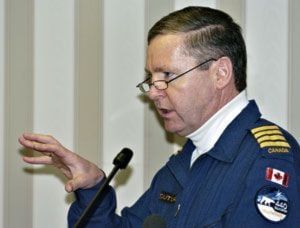The recent federal election didn’t make much difference to Col. Norm Couturier.
The leaders of Canada’s three mainstream political parties all made reference to Arctic sovereignty in their campaigns.
The Conservative Party won, but it’s not as though they brought anything new to the table, the commander of Canada’s northern military said Thursday.
“It’s pretty much the same,” Couturier said during a Whitehorse Chamber of Commerce luncheon at the Westmark Whitehorse Hotel.
“The former government had recognized that the Canadian Forces had been depleted in terms of funding for so many years,” he said.
“The new government, during the election campaign, committed to spend whatever is necessary to make sure that the Canadian Forces will be there to defend the North and assert sovereignty and so on.
“I think it looks very positive.”
But exactly what support the Conservatives will bring to the Canadian Forces remains to be seen.
“Where is the new government going? Not quite sure,” Couturier told a group of about 20 people who paid $25 each to have lunch and hear him speak.
“ (National Defence) minister Gordon O’Connor wants the Canadian Forces and Joint Task Force North to take a look and see what makes sense in the Arctic, in terms of what we need to improve sovereignty, surveillance, search-and-rescue, all of that.
“How can we increase the footprint? We’re going through that right now.
“We have a week or so to put a wish list or brainstorming list together.”
Couturier commands the Joint Task Force (North) that is responsible for Canada’s Arctic sovereignty.
Gone are the days of the Cold War, when Canada faced a constant threat of invasion from the Soviet Union, he said.
But there are new threats to Canada’s Arctic sovereignty.
Like Denmark.
That nation made headlines in 2003 when it planted a flag on Hans Island, a 1.3-square-kilometre patch off the coast of Ellesmere Island that Canada has claimed for years.
“We had to go and take it down,” said Couturier of the flag, a horizontal white cross on a red field.
The two nations agreed to resolve the dispute diplomatically.
In 2004, Canada signed on to a United Nations “law of the sea” initiative that gives 10 years for countries to map out the underwater continental shelves of their sovereign territory, said Couturier.
Canada stands to gain territory in the North Atlantic, along the Grand Banks, and in the High Arctic, he added.
The second threat to Canada’s Arctic sovereignty comes from the US.
The US has recently suggested altering the offshore border between the two countries.
Traditionally the boundary has been marked from the coast to the North Pole by the 141st parallel.
“It wasn’t an issue until large reserves of oil were discovered in the Beaufort Sea,” said Courturier.
“The Americans would like to see the border perpendicular to the coast, as opposed to along the 141st parallel.”
And the third issue is the Northwest Passage.
“Canada has always stated that the passage is internal, national waters, and the reason is obvious,” said Couturier.
“As there is global warming, the passage is open longer and will be more navigable.
“Even supertankers would benefit if they were to travel eastbound by using the Northwest Passage.
“Interestingly, last year the outgoing ambassador for the US stated in Iqaluit at a press conference that the US would be better served if the Northwest Passage remained Canadian national waters, simply because it would be better policed than if it was international.
“To us, it is national waters.”
There are lots of ways for Canada to assert its sovereignty, such as satellite surveillance, regular unmanned aerial-vehicle flights and a greater role for the Canadian Rangers, said Couturier.
On Thursday, O’Connor asserted Ottawa’s commitment to northern sovereignty at a news conference.
“It is our intention to devote more people, more equipment and more money to defence of our great northern areas,” he said in Ottawa.
O’Connor pledged to increase Canada’s regular armed forces from 62,000 troops to “at least” 75,000, and reserve personnel from 23,000 to 33,000.
Search-and-rescue capacity should also be a priority, said Couturier.
Between 400 and 450 trans-polar flights cross Canada’s Arctic every day, and, eventually, there’s going to be a crash of some kind and a subsequent rescue operation, he said.
Many of those flights are heading from the southern US to Southeast Asia, and survivors dressed in light summer clothes won’t last long in minus 50 Celsius, said Couturier.
Extreme adventurers — folks who try paddling the Northwest Passage, for instance — are the “greatest nuisance” when they have to be rescued, he added.
Couturier would like to see Ottawa put five fixed-wing aircraft north of 60, mostly in Yellowknife, and equip them with infrared sensors and search-and-rescue capacities to serve the triple purpose of conducting surveillance, deploying Canadian Rangers and rescuing air passengers in distress.
It’s not like Canada can rule out the possibility of foreign terrorists infiltrating the Arctic either, he added.
Domestic passengers and their baggage are not screened as long as they stay north of 60, he said.
“Security in the Arctic has not received the level of attention it deserves. If you stay north of 60, you’ll never be screened.”
As for Whitehorse, Couturier has proposed a greater role for the cadet camp at the Canadian Forces Yukon detachment near Mary Lake, and more than the half-dozen regular and reserve soldiers currently on hand.
